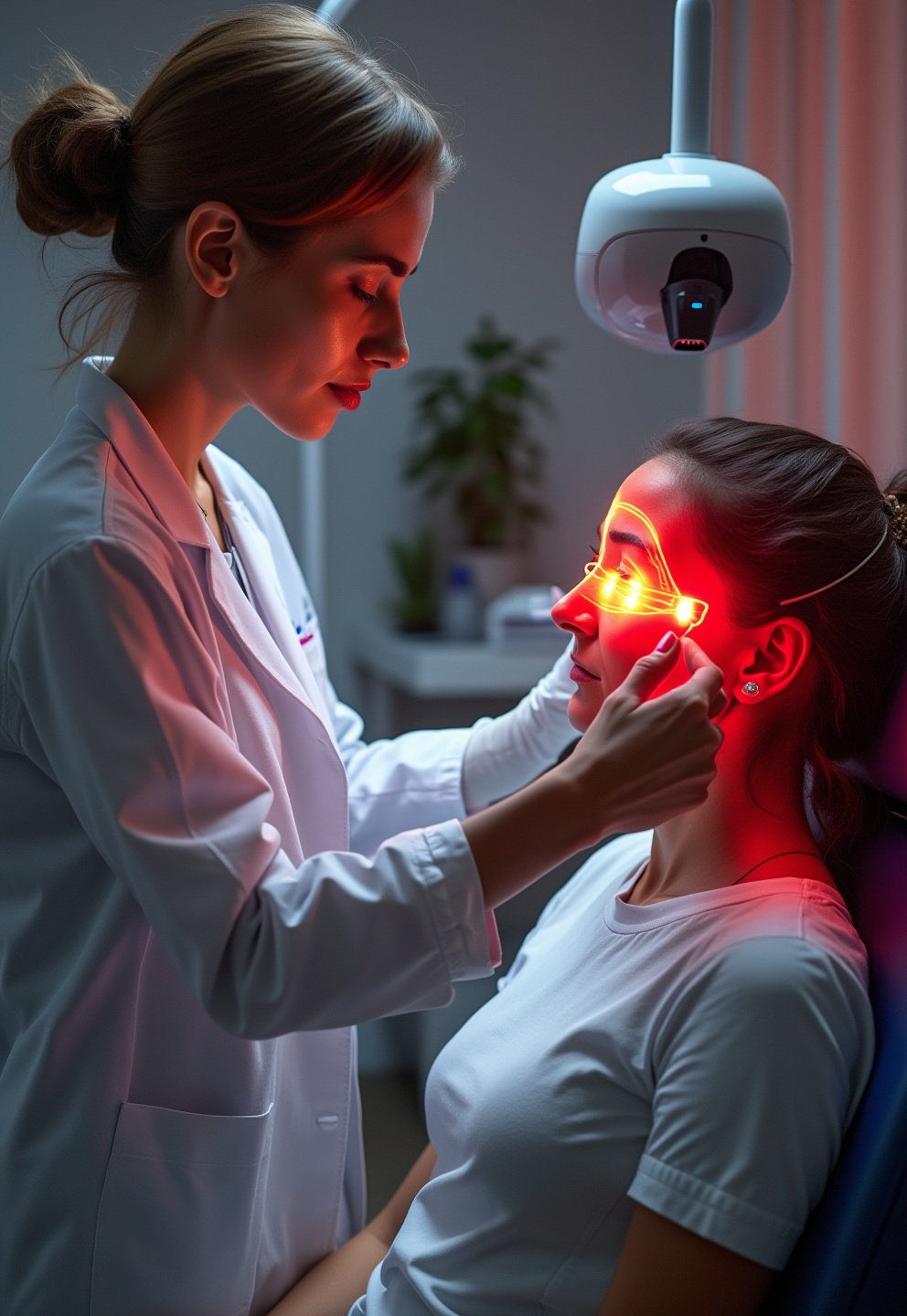7 Truths: Does Red Light Therapy Cause Cancer (Is it safe?)

Does Red Light Therapy Cause Cancer? A Look at the Facts

Can red light therapy cause cancer? After reviewing thousands of studies, scientists agree: red light therapy does not start or create cancer.
However, there is a theory that it could speed up the growth of existing cancer cells. This is a key difference to understand.
So far, this speeding-up effect has mostly been seen in lab test tubes (in vitro). Importantly, these results haven’t been repeated in studies with people or animals (in vivo).
There is no evidence that red light therapy can create cancer in a healthy person. The main piece of advice is to avoid shining red light directly onto a known, existing tumor. This is true even though most animal studies show no negative effects and some even show a reduction in tumors.
This leaves us with a theory that RLT *could* make an existing cancer worse. But again, this has not been proven in living beings.
What Do Scientists Say About RLT and Cancer?

You may have heard that red light therapy can help with pain, wrinkles, and inflammation. But is it safe to use if you already have cancer?
The overwhelming answer from current research is, “Yes, it appears to be safe.” In fact, it’s often used to help with the tough side effects of standard cancer treatments.
The official advice is to be careful when applying it directly over a known tumor. This is a smart safety step, not proof that it’s dangerous.
Leading researchers, like Dr. Michael Hamblin from Harvard and MIT, confirm that red light therapy is a very helpful and widely-supported tool for easing cancer treatment side effects like oral mucositis.
So, while the therapy helps with side effects, the tricky part is using it directly on tumors. The warning is based more on theory than on real evidence of it causing harm.
How Does Red Light Therapy Actually Work?

To understand why red light therapy is safe, it helps to remember that light is not a drug. Our bodies are built to use certain kinds of light in healthy ways.
For example, our bodies use blue light to manage our sleep-wake cycles (circadian rhythms). We use ultraviolet (UV) light from the sun to make vitamin D, a vital hormone for our health.
Unlike a drug that forces a certain chemical reaction, red light therapy works by helping the body’s natural processes. Specific types of red and near-infrared light are absorbed by the mitochondria, the power plants inside our cells.
This process gives our cells more energy and helps blood flow better. With this extra energy, your body can heal itself more effectively.
Since light is a natural part of our biology, red light therapy has almost no side effects for most people when they use it correctly.
The “Worst Quality” of Red Light Therapy Explained

If red light therapy has a “worst quality,” it’s that its greatest strength could also be a theoretical weakness. The therapy is great at helping cells stay healthy and grow, which is its main benefit.
This benefit is what helps heal wounds, build collagen, and reduce inflammation. However, this same action creates the theoretical risk when it comes to existing cancer.
Because cancer is a condition where cells grow out of control, the worry is that giving these cells extra energy might speed up their growth.
It’s important to remember this is just a theory based on lab observations. Current animal and human studies do not show this happening in a living body.
The “worst quality” of red light therapy might just be that it “works too hard,” which calls for a smart and careful approach when using it near active tumors.
Does RLT Really Help People with Cancer?

A review of over 190 studies on photobiomodulation (the scientific name for RLT) and cancer makes it clear: Red light therapy does not cause cancer.
The therapy uses low levels of gentle, non-ionizing light to stimulate cells. It is not the same as high-energy radiation used in cancer treatment or the DNA-damaging UV light from the sun.
Instead of causing harm, studies keep showing that red light therapy greatly eases the difficult side effects of strong cancer treatments.
A 2018 review by Dr. Hamblin, Photobiomodulation and Cancer: What Is the Truth?, concluded that RLT is very effective for easing cancer therapy side effects. It has even been shown to reduce tumors in some animal models, not help them grow.
How RLT Eases Cancer Treatment Side Effects

The proof for using red light therapy in cancer care is strong. It is proven to lessen pain and improve life for patients getting radiation and chemotherapy.
Red light therapy provides significant relief for these common side effects:
- Oral Mucositis: Painful and difficult mouth sores that result from radiation or chemotherapy.
- Acute Radiation Dermatitis: Severe skin burns, damage, and cell death that can occur after radiation.
- Dysphagia: Difficulty swallowing, a common side effect of therapy for head and neck cancers.
- Peripheral Neuropathy: Nerve damage in the hands and feet that leads to pain, tingling, and numbness.
Dozens of clinical trials confirm these benefits. Here are just a few of the many studies showing its effectiveness and safety:
- Low-level laser therapy [red light therapy] for oral mucositis in children with cancer
- Long-term safety of photobiomodulation for oral mucositis: a 15-year retrospective study
- Photobiomodulation for the prevention of acute radiation dermatitis in head and neck cancer patients
- The effect of photobiomodulation on chemotherapy-induced peripheral neuropathy: A randomized, sham-controlled clinical trial
The Petri Dish Problem: Why Lab Results Can Differ From Reality

The main worry about red light therapy and cancer comes from lab studies done in petri dishes (called in vitro studies).
In some of these tests on isolated cells, scientists saw that red light therapy could make certain cancer cells grow faster. This is where the fear started.
But here’s the puzzle: when the same tests are done on living animals or people (in vivo studies), this effect doesn’t happen. A living body is much more complex than cells in a dish.
In a living body, red light therapy affects the immune system, blood flow, and nearby tissues, creating a different overall effect. In fact, studies on living things often show the opposite—that tumor growth is slowed down or not affected at all.
What Animal and Human Studies Actually Show

While a few lab studies sparked concern, research in living organisms tells a different story. In these real-life studies, red light therapy doesn’t seem to make cancer worse.
Some studies even show that it can slow down the growth of cancer cells. For instance, one study found that red light therapy was effective in treating oral cancer in an animal model.
This healing effect might happen because red light therapy helps the immune system and improves blood vessels around a tumor. This can make it easier for your body’s own defenses to fight the cancer.
Here are studies that show this slowing or neutral effect in living organisms:
- Autophagy upregulation may explain the inhibition of oral carcinoma by photobiomodulation [red light therapy]
- Laser Therapy [red light therapy] Inhibits Tumor Growth in Mice by Promoting Immune Surveillance and Vessel Normalization
- Safety and efficacy of photobiomodulation [red light therapy] therapy in oncology: A systematic review
This shows the huge difference between a simple petri dish and a complex living body.
Why the Right Dose and Proper Use Matter

It’s important to remember that red light therapy is a “low-level” light therapy. The results depend a lot on the dose, which means the light’s power and how long you use it.
This idea is called the biphasic dose response. It means too little light does nothing, the right amount helps, and too much can cancel out the benefits or cause temporary swelling.
Using a very powerful device for too long could, in theory, push your cells in the wrong direction. But this isn’t a worry with the devices sold for home use.
Follow the device maker’s instructions for treatment times and distance. This is the best way to get all the benefits while keeping any risks extremely low.
What’s Next? A Cautious but Hopeful Outlook

The big question remains: “Does using red light therapy for cancer therapy side effects accidentally cause cancer cells to grow?”
According to all the evidence, the answer is no. A major review on tumor safety concluded that red light therapy does not cause tumors to grow faster in real-world patient care.
The confusing results from a few in vitro studies couldn’t be reliably explained when looking at the whole body.
This leads researchers to a simple and smart piece of advice: The evidence shows it’s safe. But because we’re still gathering long-term information, it’s wise to be careful about using it directly over an active tumor.
Your Takeaway: A Balanced View on RLT and Cancer

The worry about using red light therapy near cancer comes almost entirely from those petri dish studies. These findings just don’t match what happens in real life with people and animals.
A much larger pile of evidence shows that red light therapy is not just safe but also very helpful for patients going through cancer treatment. It helps them manage tough side effects and feel better.
While there’s a small, theoretical chance of unwanted effects near existing cancers, the evidence we have today suggests RLT is much more likely to help, or at least do no harm.
Until we have more long-term studies, experts agree: enjoy its proven benefits for your overall wellness and recovery. Just avoid putting it directly on any known tumors.
Want to Learn More? Dive Into the Research
- A Meta-Analysis: Red Light Therapy and Cancer Risk
- The Nuts and Bolts of Low-level Laser (Light) Therapy (Review on mechanisms and safety)
- Photobiomodulation in supportive cancer care: a review of the evidence
- Red light therapy: Can it really boost your health? (Harvard Health Publishing)
- Unveiling the Healing Power of Red Light Therapy






